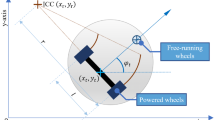Abstract
In recent years, multiple robot systems that perform team operations have been developed. These robot systems are expected to execute complicated tasks smoothly in a given congested workspace. In this article, we propose a workspace mapping algorithm using ultrasonic stereo sonar and an image sensor in order to operate the mobile robots among obstacles. This workspace mapping algorithm involves two steps: (1) the position detection of obstacles using ultrasonic stereo sonar, and (2) the shape detection of obstacles using an image sensor. While each robot moves around in the given workspace, the two steps of the mapping algorithm are repeated and sensor data are collected. The robot measures the distance and the direction of obstacles using ultrasonic stereo sonar. The shape of obstacles is also captured using an onboard image sensor. A workspace map is created based on the sensor data accumulated from the proposed method, and successful results are also obtained through experiments.
Similar content being viewed by others
Explore related subjects
Discover the latest articles, news and stories from top researchers in related subjects.References
Takai H, Mitsuoka J, Yasuda G, Tachibana K (2006) Feasibility study of sensing methods on cooperative localization for team operation of multiple mobile robots. 3rd International Conference on Autonomous Robots and Agents (ICARA2006), Palmerston North, New Zealand, 2006, pp 379–385
Takai H, Miyake M, Tachibana K (2008) Multi-robot cooperative localization and mapping using multi-sensor information fusion. Proceedings of the 39th ISR (International Symposium on Robotics 2008), Seoul, Korea, 2008, pp 342–347
Author information
Authors and Affiliations
Corresponding author
Additional information
This work was presented in part at the 14th International Symposium on Artificial Life and Robotics, Oita, Japan, February 5–7, 2009
About this article
Cite this article
Miyake, M., Takai, H. & Tachibana, K. Workspace mapping based on multisensor information fusion using heterogeneous onboard sensors. Artif Life Robotics 14, 401–404 (2009). https://doi.org/10.1007/s10015-009-0695-9
Received:
Accepted:
Published:
Issue Date:
DOI: https://doi.org/10.1007/s10015-009-0695-9




